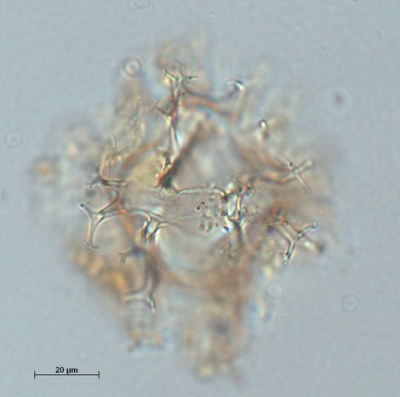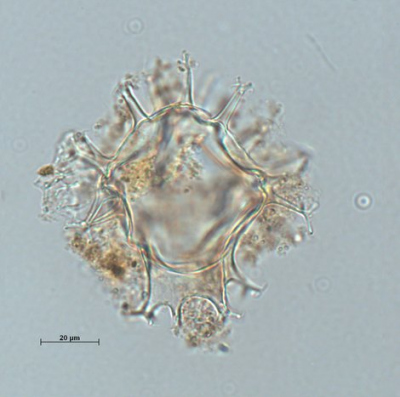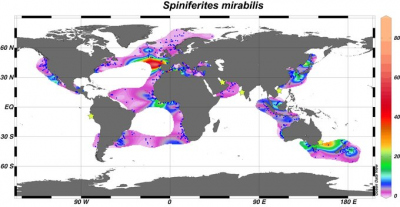Die Inhalte dieser Seite sind leider nicht auf Deutsch verfügbar.
Seitenpfad:
- Modern Dinocyst Key
- transparent cysts
- Septa and processes
- Cysts with antapical protusions
- Spiniferites mirabilis
Spiniferites mirabilis
Zonneveld, K.A.F. and Pospelova V. (2015). A determination key for modern dinoflagellate cysts. Palynology 39 (3), 387- 407.

dorsal view
photo: Karin Zonneveld
photo: Karin Zonneveld

cross section
photo: Karin Zonneveld
photo: Karin Zonneveld
Field characteristics
Field characteristics:
Proximochorate ovoid cysts with smooth to microgranulate wall. Tabulation is weakly expressed by very low sutural septa (sometimes completely absent). The antapical area is ornamented by processes that are connected by a high sutural flange along the junction of paraplates 1"" and 4"'. At the junction of these two plates with 3"' and 5"' large processes emerge from the flange. Both gonal and intergonal processes are present that are bi- and trifurcate. Archeopyle is precingular (type P).
Dimensions: Cyst body: 30 to 60 (width) to 40 to 70 (length ) µm; length of processes: 15 to 22 µm.
Motile affinity: Gonyaulax spinifera (Claparède et Lachmann 1859) Diesing 1866.
Cyst-theca relationship:
Stratigraphic range: Lower Oligocene to Recent.
Comparison with other species:
The characteristic feature of this species is a crown-like feature that result from three higher septa between four processes at antapical position. If the species is folded you can easily recognise this feature. The species has trifurcate gonal and bifurcate intergonal processes with bifurcate tips. The morphology of species S. hyperacanthus is similar to that of S. mirabilis with the exception of the presence of the „crown“. To my personal opinion (Karin) most specimens that are considered to be S. hyperacanthus are in fact S. mirabilis specimens where the crown has not been recognised or is not present as a result of bad preservation of the specimen or folding as result of the preparation.
Proximochorate ovoid cysts with smooth to microgranulate wall. Tabulation is weakly expressed by very low sutural septa (sometimes completely absent). The antapical area is ornamented by processes that are connected by a high sutural flange along the junction of paraplates 1"" and 4"'. At the junction of these two plates with 3"' and 5"' large processes emerge from the flange. Both gonal and intergonal processes are present that are bi- and trifurcate. Archeopyle is precingular (type P).
Dimensions: Cyst body: 30 to 60 (width) to 40 to 70 (length ) µm; length of processes: 15 to 22 µm.
Motile affinity: Gonyaulax spinifera (Claparède et Lachmann 1859) Diesing 1866.
Cyst-theca relationship:
Stratigraphic range: Lower Oligocene to Recent.
Comparison with other species:
The characteristic feature of this species is a crown-like feature that result from three higher septa between four processes at antapical position. If the species is folded you can easily recognise this feature. The species has trifurcate gonal and bifurcate intergonal processes with bifurcate tips. The morphology of species S. hyperacanthus is similar to that of S. mirabilis with the exception of the presence of the „crown“. To my personal opinion (Karin) most specimens that are considered to be S. hyperacanthus are in fact S. mirabilis specimens where the crown has not been recognised or is not present as a result of bad preservation of the specimen or folding as result of the preparation.
Geographic distribution
Geographic distribution based on :
Zonneveld et al., 2013. Atlas of modern dinoflagellate cyst distribution based on 2405 datapoints. Review of Palaeobotany and Palynology, v. 191, 1-197
Zonneveld et al., 2013. Atlas of modern dinoflagellate cyst distribution based on 2405 datapoints. Review of Palaeobotany and Palynology, v. 191, 1-197
Spiniferites mirabilis has a temperate to equatorial distribution and can be observed in coastal as well in open oceanic environments with the subtropial fronts forming its northern and southern boundaries. It can be present in high relative abundances in areas where salinity is reduced either seasonally or throughout the year. It can be present in oligotrophic to eutrophic environments and in regions where bottom waters are anoxic to well-ventilated.

Distribution:
Spiniferites mirabilis is observed in temperate to equatorial regions with he sub-tropical fronts forming roughly its distribution margins on both hemispheres. It has a coastal to open oceanic distribution. It is present in all major upwelling areas world-wide but is not typically abundant in these regions. High abundances (up to 76%) occur in the northern and southern Pacific and Atlantic Oceans at around 30-40°N and 30-40° S. Another optimum is observed around the equator.
Environmental parameter range:
SST: -0.8 - 29.8°C (winter - spring), SSS: 17.5 - 39.4 (summer - autumn), [ P]: 0.06 - 1.24 μmol/l, [N]: 0.05 - 16.38 μmol/l, chlorophyll-a: 0.05 - 21.76 ml/l, bottom waters [O2]: 0.01 - 7.4 ml/l.
In the North Pacific and North Atlantic S. mirabilis sporadically occurs in regions where winter SST are < 0°C. At these sites seasonal contrast is large and summer SST varies between 10.7 and 15.1°C. SSS can be reduced seasonally or throughout the year for instance by river discharge e.g. in the Black Sea and Marmara Sea. High relative abundances of Spiniferites mirabilis occur in eutrophic regions.
Comparison with other records:
Apart from the records in the dataset of this Atlas, Spiniferites mirabilis has been observed in surface sediments of coastal sites of the South China Sea, the Gulf of Oman, off India (eastern Arabian Sea), and the upwelling area off Peru (eastern equatorial Pacific, Bradford, 1975; Biebow et al., 1993; Godhe et al., 2000; Marret and Zonneveld, 2003).
In the Arabian Sea, cysts of Spiniferites mirabilis are typically formed during upwelling relaxation after termination of the southwest monsoon (Zonneveld and Brummer, 2000). In seasonal distribution and sediment trap studies off the Iberian paninsula and the Omura Bay (West Japan) no clear season relationship between cyst production and seasonal variability in environment can be documented (Fujii and Matsuoka, 2006; Ribeiro and Amorim, 2008).
Although it is occasionally observed in regions where SST may be < 0°C in winter, it is not observed in areas where seasonal ice covered occurs (de Vernal et al., 1998; Radi and de Vernal, 2008)
Spiniferites mirabilis is observed in temperate to equatorial regions with he sub-tropical fronts forming roughly its distribution margins on both hemispheres. It has a coastal to open oceanic distribution. It is present in all major upwelling areas world-wide but is not typically abundant in these regions. High abundances (up to 76%) occur in the northern and southern Pacific and Atlantic Oceans at around 30-40°N and 30-40° S. Another optimum is observed around the equator.
Environmental parameter range:
SST: -0.8 - 29.8°C (winter - spring), SSS: 17.5 - 39.4 (summer - autumn), [ P]: 0.06 - 1.24 μmol/l, [N]: 0.05 - 16.38 μmol/l, chlorophyll-a: 0.05 - 21.76 ml/l, bottom waters [O2]: 0.01 - 7.4 ml/l.
In the North Pacific and North Atlantic S. mirabilis sporadically occurs in regions where winter SST are < 0°C. At these sites seasonal contrast is large and summer SST varies between 10.7 and 15.1°C. SSS can be reduced seasonally or throughout the year for instance by river discharge e.g. in the Black Sea and Marmara Sea. High relative abundances of Spiniferites mirabilis occur in eutrophic regions.
Comparison with other records:
Apart from the records in the dataset of this Atlas, Spiniferites mirabilis has been observed in surface sediments of coastal sites of the South China Sea, the Gulf of Oman, off India (eastern Arabian Sea), and the upwelling area off Peru (eastern equatorial Pacific, Bradford, 1975; Biebow et al., 1993; Godhe et al., 2000; Marret and Zonneveld, 2003).
In the Arabian Sea, cysts of Spiniferites mirabilis are typically formed during upwelling relaxation after termination of the southwest monsoon (Zonneveld and Brummer, 2000). In seasonal distribution and sediment trap studies off the Iberian paninsula and the Omura Bay (West Japan) no clear season relationship between cyst production and seasonal variability in environment can be documented (Fujii and Matsuoka, 2006; Ribeiro and Amorim, 2008).
Although it is occasionally observed in regions where SST may be < 0°C in winter, it is not observed in areas where seasonal ice covered occurs (de Vernal et al., 1998; Radi and de Vernal, 2008)


